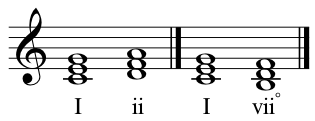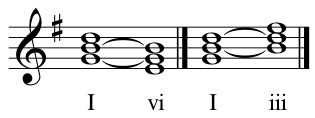Any two different chords in sequence constitute a harmonic progression. The relationship between the two chosen chords can be quantified according to its strength, where stronger progressions sound more “convincing”. However a progression containing only strong relationships can sound boring and predictable, so you should not treat the terms “strong” and “weak” as perjorative, you need to balance both types in your compositions.
Given that a triad has only three notes, there are only three basic relationships between any two triads:
- The triads have no notes in common.
- The triads have one note in common.
- The triads have two notes in common.
Of course if the triads have all three notes in common they are the same so that doesn’t count.
In any given key, triads with no notes in common can only occur when the roots are a second (or a seventh) apart. They are said to be in second relation:

These are the strongest progressions, but not the most important, since they are somewhat too strong for continuous use.
Chords in any given key with only one note in common can only occur if the roots are a fourth or a fifth apart. They are said to be in quartan (4) or quintal (5) relation:
These progressions are the most common, because they include both the authentic and plagal cadences.
Chords with two notes in common, in a given key, can only occur if the roots are a third (sixth) apart, in which case they are said to be in tertian relation:

These progressions are considered relatively weak, but remember that weak does not mean undesirable.
Beyond the basic classification above, we can further categorize progressions into whether they are ascending or descending. Simply put, an ascending progression is when the root of the second chord is not in the first cord. Ascending progressions are considered stronger. Descending progressions then, are those where the first chord contains the root of the second and are considered relatively weak.
We can therefore describe the relationships between two chords any interval apart as follows:
- second
- second relation, ascending (super strong)
- third
- tertian relation, descending (weak)
- fourth
- quartan relation, ascending (strong)
- fifth
- quintal relation, descending (relatively strong)
- sixth
- tertian relation, ascending (relatively weak)
- seventh
- second relation, ascending (super strong)
